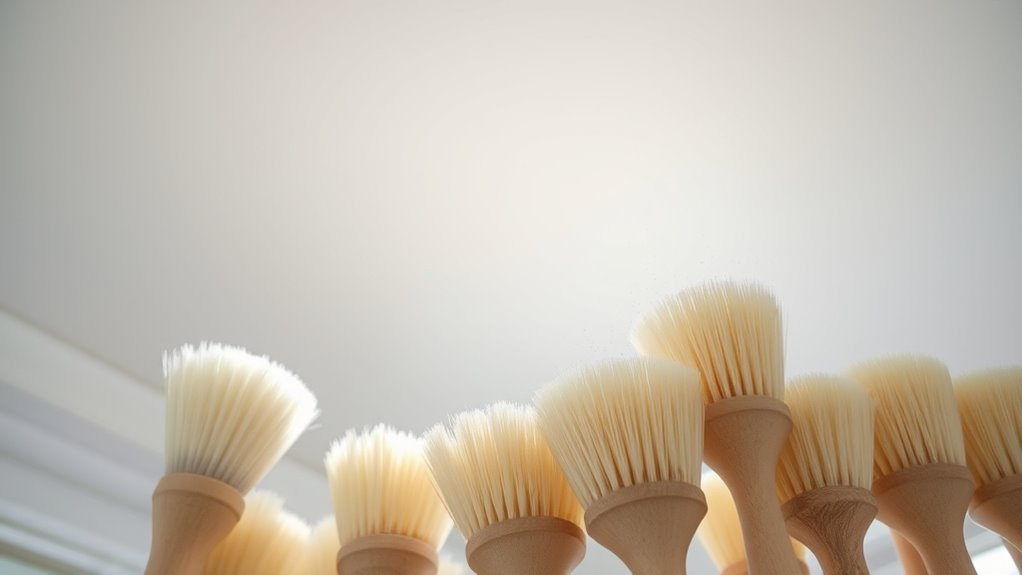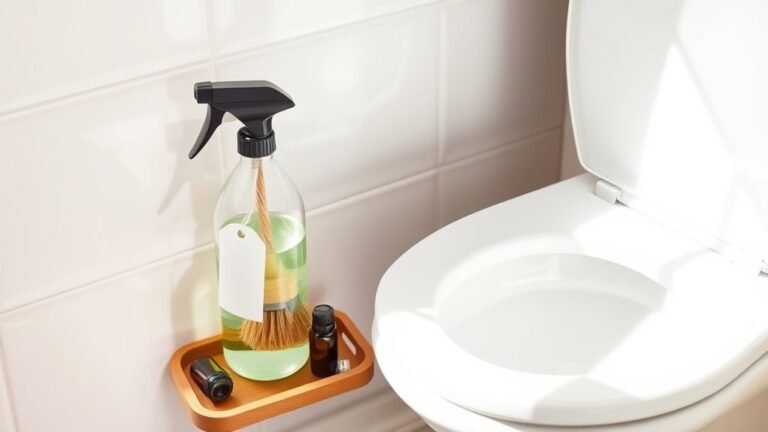Essential Tools for Cleaning Ceilings
To clean ceilings effectively, you’ll want telescoping extension poles to reach high spots safely, along with a sturdy ladder or step stool for stability. Use microfiber dust mops or soft-bristle brushes to trap dust gently without damage. Spray bottles with eco-friendly solutions help remove grime carefully. Don’t forget protective gear like goggles and gloves for safety. Vacuum cleaners with specialized attachments also boost efficiency. Understanding these tools in detail will help you clean ceilings more thoroughly and safely.
Telescoping Extension Poles

When cleaning ceilings, you’ll often need a tool that extends your reach without compromising control. Telescoping extension poles offer significant advantages by allowing you to adjust length easily, providing access to high or awkward areas while maintaining stability. These poles come in various types, including aluminum, fiberglass, and carbon fiber, each balancing weight, durability, and cost differently. Aluminum poles are sturdy and affordable but heavier, while fiberglass offers lightweight strength and insulation properties. Carbon fiber poles are the lightest and most durable but tend to be pricier. Choosing the right telescoping pole type depends on your cleaning needs and freedom of movement. With the right pole, you gain the freedom to clean ceilings efficiently, avoiding ladders and reducing strain.
Microfiber Dust Mops
When cleaning ceilings, you’ll find microfiber dust mops highly effective at trapping dust without scattering it. They’re lightweight and easy to maneuver, allowing you to reach high or awkward spots with minimal effort. Plus, microfiber heads are reusable, making them an eco-friendly choice for regular maintenance.
Dust Removal Efficiency
Although ceilings are often overlooked, their dust accumulation can greatly affect indoor air quality and overall cleanliness. Microfiber dust mops excel in capturing varied dust particle sizes across different ceiling surface types. Their microfibers attract and hold fine particles, preventing redistribution. To enhance dust removal efficiency, consider mop material, ceiling texture, and particle size.
| Ceiling Surface Type | Typical Dust Particle Size | Mop Efficiency (%) |
|---|---|---|
| Smooth | 1-10 microns | 95 |
| Textured | 5-20 microns | 90 |
| Popcorn | 10-30 microns | 85 |
| Painted | 1-15 microns | 93 |
| Acoustic | 5-25 microns | 88 |
This methodical approach promotes ideal dust removal, maintaining a healthier environment.
Lightweight and Maneuverable
Maximizing dust removal efficiency depends not only on the mop’s material and compatibility with ceiling textures but also on its ease of use. Choosing a microfiber dust mop with a lightweight design guarantees you can clean ceilings without fatigue or strain. This easy handling allows you to reach high or awkward spots effortlessly, giving you greater freedom of movement. The mop’s balanced weight prevents arm exhaustion, enabling longer cleaning sessions without discomfort. Its maneuverability lets you glide smoothly along intricate ceiling contours, maintaining consistent contact for effective dust capture. Prioritizing a lightweight and maneuverable dust mop enhances your cleaning efficiency while preserving your energy, so you can achieve spotless ceilings with minimal effort and maximum control.
Reusable and Eco-Friendly
Since you want to maintain both cleanliness and environmental responsibility, choosing reusable microfiber dust mops is a smart option. These mops are crafted from sustainable materials that reduce waste and support eco friendly practices. By opting for reusable microfiber pads, you minimize disposable product use, cutting down landfill contributions. Their design efficiently traps dust and allergens, improving air quality without chemical cleaners. You’ll find they’re easy to wash and dry, allowing repeated use without losing effectiveness. Incorporating these tools into your cleaning routine not only guarantees thorough ceiling maintenance but also aligns with a sustainable lifestyle. This methodical approach empowers you to maintain a clean environment while embracing freedom from single-use cleaning supplies.
Ladder or Step Stool
Choosing the right ladder or step stool is essential for safely reaching and cleaning ceilings. You want a tool that balances ease of use with safety precautions and ladder stability. Here’s what to take into account:
- Height and Reach: Verify it allows you to comfortably access the ceiling without overstretching.
- Stability: Opt for models with wide bases and non-slip feet to prevent wobbling.
- Weight Capacity: Check the maximum load to support your weight plus any cleaning tools.
Soft-Bristle Brushes

When choosing a soft-bristle brush, consider materials like natural or synthetic fibers for gentle yet effective cleaning. Select a brush size that fits the ceiling area you’re tackling to guarantee even coverage without strain. Use smooth, controlled strokes to avoid damage while loosening dust and debris efficiently.
Brush Material Types
Although hard-bristle brushes might seem effective, soft-bristle brushes are essential for cleaning ceilings without causing damage. When choosing brush materials, you want to balance brush durability with gentle cleaning power, ensuring your ceiling stays intact while you enjoy freedom from grime.
Consider these common soft-bristle materials:
- Natural fibers: Offer excellent flexibility and are gentle, but require careful brush maintenance to prevent wear.
- Synthetic fibers: Provide superior brush durability and resist moisture, making them easier to clean and maintain.
- Blended fibers: Combine the advantages of both, giving you durability and softness for efficient ceiling cleaning.
Selecting the right brush material helps preserve your ceiling’s surface and extends your brush’s lifespan, allowing you to clean effectively without unnecessary effort or damage.
Ideal Brush Sizes
An ideal brush size for soft-bristle ceiling cleaning strikes a balance between coverage area and maneuverability. You’ll want to select ideal brush types that offer soft bristles about 3 to 5 inches wide; this width covers enough surface without sacrificing control. Proper brush lengths usually range from 8 to 12 inches, allowing you to reach corners and edges comfortably while keeping hand fatigue minimal. Longer handles can be added if you need extended reach, but the brush head size remains critical for effective dust and dirt removal. Choosing the right size guarantees you clean efficiently without damaging delicate ceiling textures. With these specifications, you maintain freedom in movement and precision in cleaning, making your ceiling maintenance both thorough and effortless.
Cleaning Technique Tips
Getting started with soft-bristle brushes means focusing on gentle, consistent strokes to avoid damaging your ceiling’s texture. To maintain an effective cleaning routine, consider these technique tips:
- Use slow, even motions to prevent uneven wear or streaks.
- Clean in sections, ensuring you don’t miss spots or overwork any area.
- Follow proper safety precautions, such as securing ladders and wearing protective eyewear.
Adjust your cleaning frequency based on your environment; dustier rooms may need more regular attention. Remember, being methodical and gentle preserves the ceiling’s finish while freeing you from repeated deep cleans. By combining these soft-bristle brush techniques with proper safety, you can confidently maintain ceilings that look fresh and undamaged over time.
Spray Bottles and Cleaning Solutions

When tackling ceiling cleaning, choosing the right spray bottle and cleaning solution is essential to guarantee effective results without damaging the surface. Start with a spray bottle that offers adjustable nozzles, allowing you to control the mist or stream depending on the ceiling material and dirt type. Opt for eco-friendly, non-abrasive cleaning solutions tailored to your ceiling’s finish—this prevents discoloration or damage. Mastering spray techniques is key: hold the bottle about 12 inches from the surface and apply an even, gentle mist to avoid over-saturating. For stubborn grime, a targeted stream works better. Always test your chosen cleaning solution on a small, inconspicuous area first. With the right tools and careful spray techniques, you’ll achieve a cleaner ceiling while maintaining its integrity and your freedom to clean efficiently.
Protective Gear and Eye Protection
While selecting the right spray bottle and cleaning solutions helps protect your ceiling, you also need to safeguard yourself during the process. Taking proper safety precautions guarantees you can clean freely without injury or discomfort. Start by wearing protective clothing to shield your skin from harsh chemicals and debris. Don’t forget eye protection—goggles or safety glasses prevent irritants from causing damage or distraction. Finally, consider gloves to maintain grip and avoid skin irritation. Here’s what you should have on hand:
- Durable protective clothing to cover exposed skin
- Safety goggles to guard your eyes from splashes and dust
- Chemical-resistant gloves for hand protection and better handling
Vacuum Cleaners With Attachments
Many vacuum cleaners come with specialized attachments that make ceiling cleaning more efficient and thorough. Using the right vacuum attachments enhances suction power, allowing you to remove dust and cobwebs without damaging delicate surfaces. Extendable wands and angled brushes give you freedom to reach high or awkward spots effortlessly.
| Attachment Type | Purpose | Best For |
|---|---|---|
| Crevice Tool | Tight corners and edges | Corners, molding |
| Dusting Brush | Gentle dust removal | Light fixtures, fans |
| Extension Wand | Reach high ceilings | Tall rooms, vaulted ceilings |
| Upholstery Tool | Soft surface cleaning | Fabric ceiling panels |
| Flexible Hose | Maneuverability | Hard-to-reach areas |
Selecting attachments wisely guarantees peak suction power and freedom to clean ceilings effectively.
Frequently Asked Questions
How Often Should Ceiling Cleaning Be Done?
You should follow frequency guidelines based on your environment—typically, ceilings need cleaning every six months to a year. If you’re in a high-traffic or dusty area, you might want to adjust your cleaning schedules to every three months. Sticking to a regular routine helps maintain your space’s freshness and prevents buildup, giving you the freedom to enjoy a clean, healthy home without unexpected deep cleaning sessions.
Are There Specific Ceiling Types That Need Special Cleaning?
Imagine your ceiling as a delicate canvas—some types demand special care. Acoustic tiles, for instance, are porous and can trap dust; you’ll want to use a gentle vacuum or soft brush to avoid damage. Painted surfaces, on the other hand, can be wiped with a damp cloth and mild detergent, but harsh scrubbing can strip paint. Knowing your ceiling type lets you clean effectively while preserving its freedom to shine.
Can Ceilings Be Cleaned Without Any Chemicals?
Yes, you can clean ceilings without chemicals by using natural cleaning and eco-friendly methods. Simple tools like microfiber cloths and soft brushes help remove dust effectively. Mixing water with vinegar or lemon juice creates a gentle, natural cleaner safe for most ceiling types. These methods let you maintain cleanliness while respecting your desire for freedom from harsh chemicals and environmental impact, keeping your space fresh and healthy in a sustainable way.
How to Prevent Ceiling Damage During Cleaning?
To prevent ceiling damage during cleaning, you’ll want to focus on dust control and gentle cleaning techniques. Start by using a soft-bristle brush or microfiber cloth to remove dust without scrubbing harshly. Avoid excessive moisture—damp, not wet, is key. Work in small sections, and be mindful of delicate areas like texture or paint. These careful steps help you keep your ceiling intact while enjoying a fresh, dust-free space.
What Are the Signs That a Ceiling Needs Professional Cleaning?
You’ll know your ceiling needs professional cleaning if you notice ceiling discoloration that regular cleaning can’t fix. Persistent stains or patches that don’t fade often signal deeper issues. Mold growth is another clear sign—if you see black or green spots spreading, it’s time to call experts. Ignoring these signs can lead to structural damage, so addressing them promptly helps keep your space safe and your freedom from worry intact.






